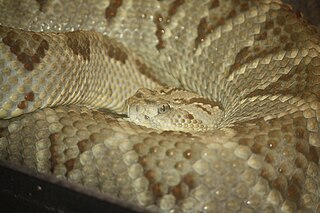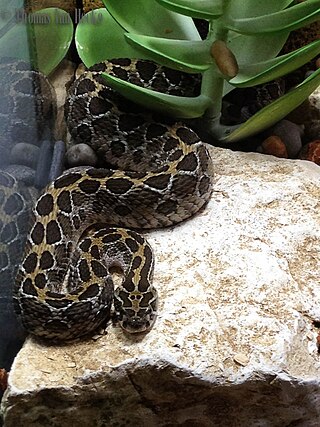
The black-tailed rattlesnake is a venomous pit viper species found in the southwestern United States and Mexico. Four subspecies are currently recognized, including the nominate subspecies described here.

Crotalus basiliscus, known as the Mexican west coast rattlesnake, Mexican green rattler, and also by other names, is a species of pit viper in the family Viperidae. The species is endemic to western Mexico. Like all other pit vipers, it is venomous. The specific name, basiliscus, is derived from the Greek word for king, βασιλισκος, and alludes to this snake's large size and potent venom. No subspecies are currently recognized.

Crotalus ruber is a venomous pit viper species found in southwestern California in the United States and Baja California in Mexico. Three subspecies are currently recognized, including the nominate subspecies described here.

Crotalus mitchellii is a venomous pit viper species in the family Viperidae. The species is endemic to the Southwestern United States and adjacent northern Mexico. The species was named in honor of Silas Weir Mitchell (1829–1914), an American medical doctor who also studied rattlesnake venoms. Five subspecies are currently recognized, including the nominate subspecies described here.

Crotalus enyo, commonly known as the Baja California rattlesnake or Lower California rattlesnake, is a pit viper species native to the coast and islands of northwestern Mexico. Like all other pit vipers, it is venomous. Three subspecies are currently recognized, including the nominate subspecies described here.

Crotalus ravus, commonly known as the Mexican pigmy rattlesnake or Mexican pygmy rattlesnake, is a venomous pit viper species, found only in Mexico. Three subspecies are currently recognized.

Crotalus simus is a venomous pit viper species found in Mexico and Central America. The specific epithet is Latin for "flat-nosed", likely because its head is blunt compared with lanceheads (Bothrops). Three subspecies are recognized, including the nominate subspecies described here.

Crotalus oreganus, commonly known as the (northern) Pacific rattlesnake, is a venomous pit viper species found in western North America from the Baja California Peninsula to the southern interior of British Columbia.

Crotalus atrox tortugensis is a venomous pit viper subspecies found only on Tortuga Island in the Gulf of California.

Crotalus aquilus, known as the Querétaro dusky rattlesnake or Queretaran dusky rattlesnake, is a pit viper species found in the highlands of central Mexico. Like all other pit vipers, it is venomous. No subspecies are currently recognized. The specific name, aquilus, is Latin for "eagle" and refers to the high altitude at which this species is found.

Crotalus intermedius is a pit viper species found in central and southern Mexico. Like all other pit vipers, it is venomous. Three subspecies are currently recognized, including the nominate subspecies described here.

Crotalus pricei is a species of venomous snake, a pit viper in the family Viperidae. The species is endemic to the southwestern United States and northern Mexico. Two subspecies are recognized.

Crotalus lannomi, known commonly as the Autlán rattlesnake, is a species of venomous snake, a pit viper in the family Viperidae. The species is endemic to southwestern Mexico. There are no subspecies that are recognized as being valid.

The Mexican lance-headed rattlesnake or lance-headed rattlesnake is a venomous pit viper species found in central Mexico. No subspecies is currently recognized.

Crotalus stejnegeri, commonly known as the Sinaloan long-tailed rattlesnake or just long-tailed rattlesnake, is a venomous pit viper species in the family Viperidae. The species is native to western Mexico. There are no recognized subspecies.

Crotalus transversus, or the Cross-banded Mountain Rattlesnake, is a venomous pit viper species found in central Mexico, known from less than 20 specimens. No subspecies are currently recognized.

Crotalus triseriatus is a venomous pit viper species found in Mexico. Two subspecies are currently recognized, including the nominate subspecies described here.
Crotalus totonacus is a venomous pit viper species found in northeastern Mexico. No subspecies are currently recognized.

Crotalus estebanensis, commonly known as the San Esteban Island rattlesnake, is a pit viper species endemic to San Estéban Island, Mexico. Like all other pit vipers, it is venomous.
Crotalus lorenzoensis, or the San Lorenzo Island Rattlesnake, is a species of pit viper.




















